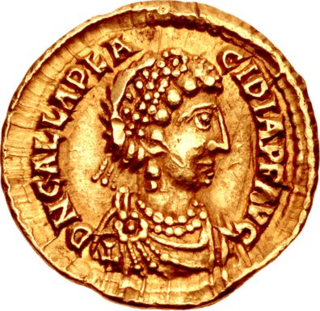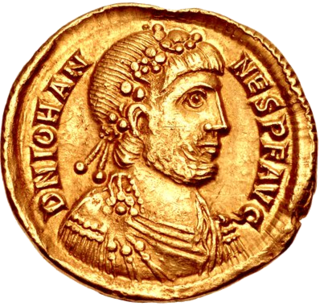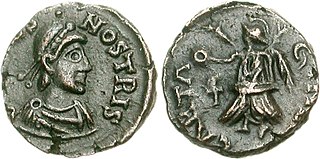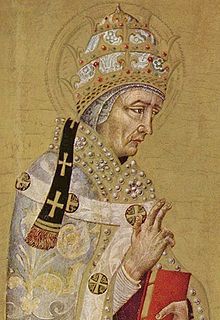Related Research Articles

Galla Placidia, daughter of the Roman emperor Theodosius I, was a mother, tutor, and advisor to emperor Valentinian III, and a major force in Roman politics for most of her life. She was queen consort to Ataulf, king of the Visigoths from 414 until his death in 415, briefly empress consort to Constantius III in 421, and managed the government administration as a regent during the early reign of Valentinian III, until her death.
Pope Benedict VII was the bishop of Rome and ruler of the Papal States from October 974 to his death.
Pope Boniface I was the bishop of Rome from 28 December 418 to his death on 4 September 422. His election was disputed by the supporters of Eulalius until the dispute was settled by Emperor Honorius. Boniface was active in maintaining church discipline, and he restored certain privileges to the metropolitical sees of Narbonne and Vienne, exempting them from any subjection to the primacy of Arles. He was a contemporary of Augustine of Hippo, who dedicated to him some of his works.
Antipope Boniface VII, otherwise known as Franco Ferrucci, was a Catholic prelate who claimed the Holy See in 974 and from 984 until 985. A popular tumult compelled him to flee to Constantinople in 974; he carried off a vast treasure, and returned in 984 and removed Pope John XIV (983–984) from office. He is supposed to have put Pope Benedict VI to death. After a brief second rule, he died under suspicious circumstances. He is today considered an antipope.
The 420s decade ran from January 1, 420, to December 31, 429.

Year 418 (CDXVIII) was a common year starting on Tuesday of the Julian calendar. At the time, it was known as the Year of the Consulship of Honorius and Theodosius. The denomination 418 for this year has been used since the early medieval period, when the Anno Domini calendar era became the prevalent method in Europe for naming years.
The 410s decade ran from January 1, 410, to December 31, 419.
Pope Symmachus was the bishop of Rome from 22 November 498 to his death. His tenure was marked by a serious schism over who was elected pope by a majority of the Roman clergy.
Pope Hormisdas was the bishop of Rome from 20 July 514 to his death. His papacy was dominated by the Acacian schism, started in 484 by Acacius of Constantinople's efforts to placate the Monophysites. His efforts to resolve this schism were successful, and on 28 March 519, the reunion between Constantinople and Rome was ratified in the cathedral of Constantinople before a large crowd.

Joannes or John was western Roman emperor from 423 to 425.
Dioscorus was a deacon of the Alexandrian and the Roman church from 506. In a disputed election following the death of Pope Felix IV, the majority of electors picked him to be pope, in spite of Pope Felix's wishes that Boniface II should succeed him. However, Dioscorus died less than a month after the election, allowing Boniface to be consecrated pope and Dioscorus to be branded an antipope.

Justa Grata Honoria, commonly referred to during her lifetime as Honoria, was the older sister of the Western Roman Emperor Valentinian III. She is famous for her plea of love and help to Attila the Hun, which led to his proclamation of his claim to rule the Western Roman Empire.

Bonifatius was a Roman general and governor of the diocese of Africa. He campaigned against the Visigoths in Gaul and the Vandals in north Africa. An ally of Galla Placidia, mother and advisor of Valentinian III, Bonifacius engaged in Roman civil wars on her behalf against the generals Felix in 427-429 and Aetius in 432. Although he defeated the latter at the Battle of Rimini, Bonifacius suffered a fatal wound and was succeeded by his son-in-law Sebastianus as patricius of the Western Roman Empire.
Laurentius was the Archpriest of Santa Prassede and later antipope of the See of Rome. Elected in 498 at the Basilica Saint Mariae with the support of a dissenting faction with Byzantine sympathies, who were supported by Eastern Roman Emperor Anastasius I Dicorus, in opposition to Pope Symmachus, the division between the two opposing factions split not only the church, but the senate and the people of Rome. However, Laurentius remained in Rome as pope until 506.
Flavius Castinus held the position of patricius in the court of Roman Emperor Honorius at the time of the Emperor's death, and most likely for some time before. He also served as consul for the year 424.

The selection of the pope, the bishop of Rome and supreme pontiff of the Roman Catholic Church, prior to the promulgation of In nomine Domini in 1059 varied throughout history. Popes were often appointed by their predecessors or by political rulers. While some kind of election often characterized the procedure, an election that included meaningful participation of the laity was rare, especially as the popes' claims to temporal power solidified into the Papal States. The practice of papal appointment during this period would later result in the jus exclusivae, i.e., a right to veto the selection that Catholic monarchs exercised into the twentieth century.

The Ostrogothic Papacy was a period from 493 to 537 where the papacy was strongly influenced by the Ostrogothic Kingdom, if the pope was not outright appointed by the Ostrogothic King. The selection and administration of popes during this period was strongly influenced by Theodoric the Great and his successors Athalaric and Theodahad. This period terminated with Justinian I's (re)conquest of Rome during the Gothic War (535–554), inaugurating the Byzantine Papacy (537-752).
The Symmachian forgeries are a sheaf of forged documents produced in the papal curia of Pope Symmachus (498–514) in the beginning of the sixth century, in the same cycle that produced the Liber Pontificalis. In the context of the conflict between partisans of Symmachus and Antipope Laurentius the purpose of these libelli was to further papal pretensions of the independence of the Bishops of Rome from criticisms and judgment of any ecclesiastical tribunal, putting them above law clerical and secular by supplying spurious documents supposedly of an earlier age. "During the dispute between Pope St. Symmachus and the anti-pope Laurentius," the Catholic Encyclopedia reports, "the adherents of Symmachus drew up four apocryphal writings called the 'Symmachian Forgeries'. ... The object of these forgeries was to produce alleged instances from earlier times to support the whole procedure of the adherents of Symmachus, and, in particular, the position that the Roman bishop could not be judged by any court composed of other bishops."

The Lateran Council of 769 was a synod held in the Basilica of St. John Lateran to rectify perceived abuses in the papal electoral process which had led to the elevation of the antipopes Constantine II and Philip. It also condemned the rulings of the Council of Hieria. It is perhaps the most important Roman council held during the 8th century.

The Mausoleum of Honorius was a late antique circular mausoleum and the burial place of the Roman emperor Honorius and other 5th-century imperial family members. Constructed for the augustus of the western Roman Empire beside Old St Peter's Basilica in Rome, the Mausoleum of Honorius was the last Roman imperial mausoleum built.
References
- 1 2 3 4 5 Barmby, J., "Eulalius, an antipope", A Dictionary of Early Christian Biography, (Henry Wace, ed.), John Murray, London, 1911
- ↑ Stewart Oost, Galla Placidia Augusta: A biographical essay (Chicago: University Press, 1968), p. 157
- ↑ Oost, Galla Placidia Augusta, pp. 157f
- ↑ Oost, Galla Placidia Augusta, pp. 167f
- ↑ Oost, Galla Placidia Augusta, pp. 161f
- ↑ Raymond Davis (translator), The Book of Pontiffs (Liber Pontificalis), first edition (Liverpool: University of Liverpool Press, 1989), pp. 33f
![]() This article incorporates text from a publication now in the public domain : Wace, Henry; Piercy, William C., eds. (1911). "Eulalius, antipope". Dictionary of Christian Biography and Literature to the End of the Sixth Century (3rd ed.). London: John Murray.
This article incorporates text from a publication now in the public domain : Wace, Henry; Piercy, William C., eds. (1911). "Eulalius, antipope". Dictionary of Christian Biography and Literature to the End of the Sixth Century (3rd ed.). London: John Murray.